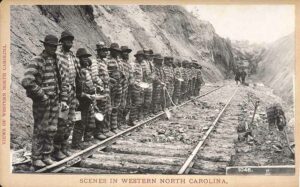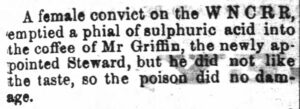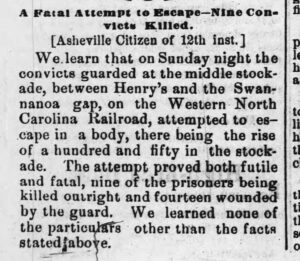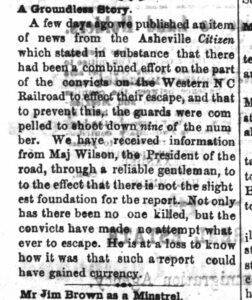
Incarcerated laborers on railroad attempted freedom
Despite being chained, watched by armed guards, and weakened by the harsh climate, brutal working conditions, communicable illnesses, and lack of food and sleep, the incarcerated laborers resisted their imprisonment.




“A female convict on the (Western North Carolina Railroad), emptied a phial of sulphuric acid into the coffee of Mr. Griffin, the newly appointed Steward, but he did not like the taste, so the poison did no damage,” reads a blurb in the Sunday, April 15, 1877, edition of The Charlotte Observer.
Attempting to kill or incapacitate Griffin may have been a planned first step in what was to come just days, perhaps hours, later at Round Knob stockade, near present-day Old Fort.
The stockade, consisting of a series of wooden bunkhouses, was one of several that were built along the steep mountain terrain between Old Fort and Ridgecrest to house more than 500 incarcerated laborers sent to the mountains from the State Penitentiary in Raleigh to construct the railroad line into Asheville.
At the time of the attempted poisoning, the Round Knob stockade housed at least 150 prisoners – nearly 95% of whom were Black men. Incarcerated women at the stockade, all of whom were Black, were tasked with cooking and cleaning for both prisoners and guards, giving the unnamed poisoner ample opportunity to spike Griffin’s coffee with sulfuric acid, which she had likely acquired from another prisoner who used the acid to manufacture nitroglycerin on-site.
When the poison was discovered, the woman confessed and was immediately placed under heavy guard. Still, unrest at Round Knob stockade continued to brew, and for good reason.
Life at the stockade was brutal. Incarcerated men worked seven days a week, 10 hours a day using rocks, shovels, wagons, rail cars, pick axes, and nitroglycerin to cut tunnels and lay track. Rations consisted of cornbread and beans; bacon and cabbage when available. The prisoners were chained together at night and forced to endure bitter winters and sweltering summers with little protection from the elements. When a prisoner died, he was most often unceremoniously buried beside the track and another prisoner was sent from Raleigh to take his place.
Using incarcerated laborers, however, had not been the state’s original intention. Before the railroad was completed, travelers – and supplies – could only reach Western North Carolina by scaling the mountains on foot, on horseback, or by wagon or stagecoach. This relative isolation became an emergency issue when a drought in the 1840s resulted in a total crop failure in the region. Soon after, the state of North Carolina earmarked funds to hire workers to bring the railroad westward.
But the project stalled at the foot of the mountains with the onslaught of the Civil War and again faltered when the men in charge of construction embezzled the funds earmarked for the railroad and skipped town. Though the state apprehended the criminals, they did not recover the funds nor did the men, who were wealthy, white and well-connected, serve any prison time.
Instead, the state found a new solution to their financial woes. Rather than pay workers, they sent a steady stream of men from the penitentiary in Raleigh and forced them to construct the railroad.
Though the 13th Amendment had outlawed slavery in the United States, there was a loophole; involuntary servitude could continue if it was used as punishment for a crime. And when the state of North Carolina needed free labor, even petty crimes carried extremely harsh sentences. Young, strong men and boys – some as young as 14 – were sentenced to work on the railroad for as little as stealing a newspaper. Many were wrongfully convicted.
Despite being chained, watched by armed guards, and weakened by the harsh climate, brutal working conditions, communicable illnesses, and lack of food and sleep, the incarcerated laborers resisted their imprisonment.
Asheville Citizen reported that on April 8, 1877, shortly after the failed poisoning attempt, 150 prisoners at Round Knob stockade ran as a group into the night. The woods surrounding the stockade were dense and it seemed likely that some of the prisoners would find freedom. But, according to the Citizen report, no prisoners escaped. Nine were killed by armed guards. Fourteen were wounded.
Days later, the Citizen and the numerous papers across the state that had rerun the story printed retractions. To assuage fears about the use of “convict labor,” Major James W. Wilson, the president of the railroad, denied the escape story as a hoax. No one had been killed, Wilson said, and there had been no escape attempt. Still, in its biannual report, the penitentiary noted that 42 incarcerated individuals had escaped from the Western North Carolina Railroad between Nov. 1, 1876, and Nov. 1, 1877; 34 had died.
By the time the first passenger trains traveled to Asheville from Old Fort in late 1879, nearly 150 prisoners had escaped and more than 150 had died on the tracks of disease, exposure, accidents, and escape attempts. Both those numbers would more than double over the next four years as work continued.
In 2020, a small group of volunteers from Buncombe and McDowell counties founded The RAIL Project to recognize the sacrifice of the incarcerated men and women who were forced to do the brutal work to bring the railroad into Western North Carolina. In October 2021, thanks to the generosity of donors from across the state, the group erected a memorial at Andrew’s Geyser in Old Fort, the site of the Round Knob stockade. In 2022, the group is working to identify potential grave sites on the mountain and erect informational panels about the people who constructed the railroad. To learn more or donate to the project, visit therailproject.org.
Anne Chesky Smith is the executive director of the Asheville Museum of History and treasurer for The RAIL Project.
